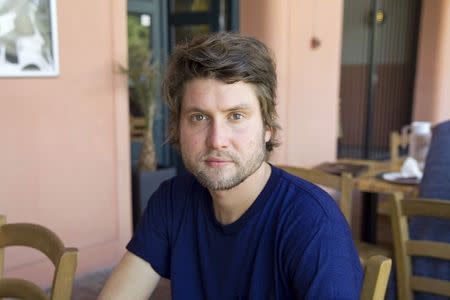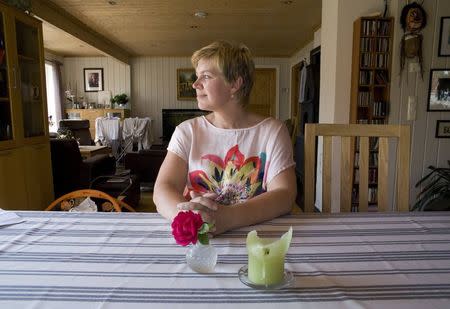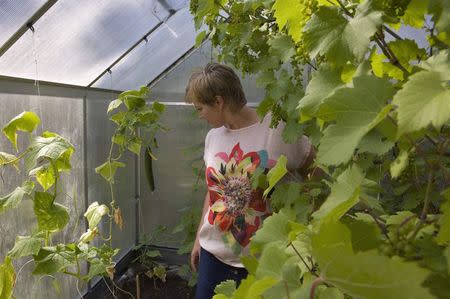Norway, survivors still bear scars of Breivik shootings
By Gwladys Fouche KONGSBERG Norway (Reuters) - Laila Gustavsen sometimes wonders whether meeting Anders Behring Breivik face-to-face would help her to understand. "I would ask him: 'What made you (do it)?'," she said of the man who shot her daughter twice in the back on July 22, 2011. "Because at every opportunity he has explained ... the political reasons why he did what he did. What he has not talked about is what made him hold these opinions. Where did it go wrong?" Then she thinks of all the reasons why it would not be worth it to try. "He does not deserve that I spend my time on him ... And I don't think you could get an answer." The fantasy of meeting her daughter's attacker is new for the 40-year-old. Two years ago, when Reuters News followed her over several months to document her life after the assaults, Gustavsen spared no thought for Breivik - she was focused on her daughter's recovery. Marte Oedegaarden, 20, spent several months in hospital. Memories of "July 22", as the attacks in central Oslo and at a youth camp on Utoeya island are commonly known, remain raw for relatives of the victims and the hundreds of survivors. (http://link.reuters.com/veh67s) For Gustavsen, a former lawmaker now working as a project manager at a polytechnic university, the reality of the assault is no longer so difficult to process. "I no longer have to pinch myself to remember that July 22 happened," she told Reuters, speaking over coffee at her home in Kongsberg, 80 km (50 miles) west of Oslo. "But sometimes I feel numb ... like you are carrying something that you haven't quite worked your way through yet." Vegard Groeslie Wennesland, 30, who escaped the Utoeya shooting by barricading himself in a red wooden cabin with 50 or so others, has found a job working for a trade union and ran - unsuccessfully - for parliament last year. Wennesland is most proud of having handed in his master's dissertation on the political life of Lebanon's Palestinian refugee camps in June. He had intended to finish it on Utoeya before the shooting, but afterward, he had trouble focusing. "I still think of it (the shooting) every day. But I guess I have learned to deal with it," he said, sitting on the terrace of a cafe in central Oslo. DEADLY DAY As a nation, Norway still grapples with what happened that day. Breivik first planted a car bomb, which killed eight when it exploded outside the prime minister's office at 3.25 p.m. on a Friday. It was a shocking, unprecedented assault on central Oslo. While police and rescue services rushed to the scene, Breivik drove out of Oslo and took the ferry to Utoeya, where the youth wing of the center-left Labour Party was holding its annual gathering. He reached the island a little before 5 p.m. Over the course of the next hour-and-a-half, disguised as a policeman, he hunted down and shot dead 69 teenagers and adults. In court, Breivik said he was trying to protect Norway from Muslim immigration and multiculturalism, and called the teenage activists on Utoeya traitors to the Norwegian nation. He said his only regret was that he did not do more damage. The building that housed the prime minister's office has remained an empty shell, decked in a dirtied white cloth, while the public debated whether to raze the building or restore it. Some said destroying it would signal a victory for Breivik. After consultations, Prime Minister Erna Solberg's cabinet decided in May that the original building would stand. Norwegian media continue to criticize the performance of the police, health and other public services whose job it has been to help the victims of July 22. "We know we could have done better. We know we could have done things better earlier," Prime Minister Solberg told the daily Dagsavisen earlier this month. "It is always difficult to reach out to all the ones who are affected." Utoeya island has not hosted a summer camp since the shooting, as some relatives believe reviving the event would amount to trampling on their loved ones' graves. Plans to cut a 3.5-metre (11.5-foot) gash at one end of the island as a memorial - a symbolic scar on the landscape - have been suspended after protests from local residents, many of whom took part in the rescue. They have said they do not want to have a constant reminder of what happened. Breivik has sat in isolation ever since his arrest. He was sentenced to the maximum time in prison of 21 years, and has been transferred to a jail in Skien, 130 km (80 miles) to the southwest of Oslo, from a prison on the outskirts of the capital. He can be kept in prison indefinitely if he is deemed a threat to society. His mother was the only person other than his lawyer allowed to visit him until she died of cancer last year. POST-TRAUMATIC STRESS Among survivors, the experience of recovery has been mixed. Adrian Pracon, now 24, came face to face with Breivik several times on July 22. "He was shouting that he was going to kill us all," Pracon told Reuters a few months after the attack. He said he was struggling with depression and how to cope in crowded places. If he was in a busy shopping mall, his instinct would be to look for the quickest escape route. In November 2011, Pracon assaulted a woman and a man in a bar. Pracon said at his trial that he could not remember why he did it. He had just seen Breivik for the first time since the shooting, during a pre-trial hearing. "I felt a strong psychological strain. Anger, hate and a lot of pain," he told the Oslo district court. "What I did was wrong and cannot be excused," he later wrote on Facebook. "But I hope we all realize the importance of giving good help to people after accidents and traumas." He was sentenced to 180 hours of community service and 10,000 crowns ($1,600) in damages to one of the victims after the court found there were mitigating circumstances in that he suffered from post-traumatic stress. Pracon did not respond to requests for interviews from Reuters. Gustavsen's daughter, Marte, has begun studying European politics at Oslo University and has bought a flat in Oslo with the compensation money that all survivors received. A fan of English soccer club Manchester United, she hopes to study at Manchester University next year, Gustavsen said. Marte herself declined to be interviewed. "I am very proud of the way we have gone through this as a family, how Marte has dealt with things," said Gustavsen. "I have become even better in tune with myself and my reactions, which I will use for the rest of my life. Which is good." For many months after the attacks, Wennesland wore an orange-and-white cotton bracelet marked with the word UTOEYA in capital letters which was given to everyone who attended the youth camp that year. He wore it as a reminder of the dead, and would often touch it without thinking. "One morning ... I took a pair of scissors and cut it off," he said. "I felt it would be a specific moment. But it just felt natural." (Reporting by Gwladys Fouche; Editing by Sonya Hepinstall)






